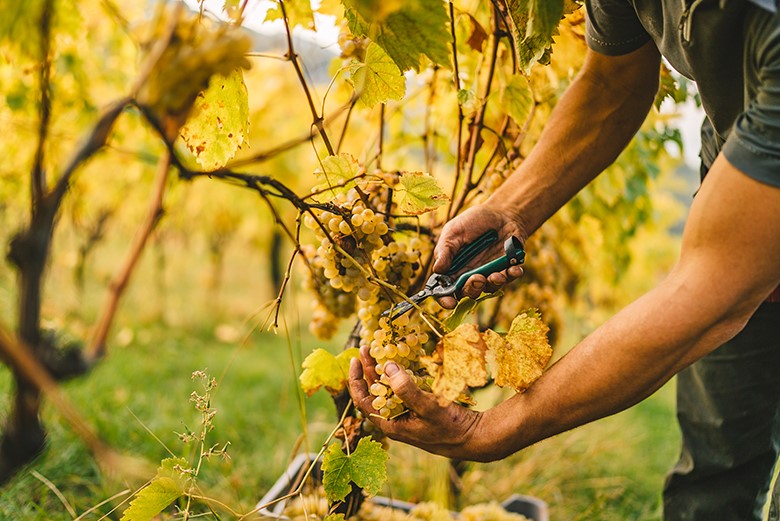
A few week’s ago we took a tour de France of the great French regions and their emblematic grape varieties. These regions all have many varieties which have been (undeservedly) forgotten by history. Interestingly, some terroir-focused vignerons are beginning to reintroduce these lesser-known grapes to their production. Let us take you on a tour de France with a difference…
Let’s start with some figures. There is an estimated total of 7,000 to 10,000 grape varieties worldwide. In France, only 250 are officially authorised by the Minister for Agriculture. With the great international varieties, this is a tendency towards the uniformisation of wine production. In France, 95% of all grapes grown come from 40 varieties. In the United States of America, only nine varietals make up 90% of all viticultural production! Italy is a significant exception to the rule, with around 750 grape varieties grown in bella Italia.
In the past, many, many more varieties were grown in France, and like Italy, every region – sometimes even sub-region (known as appellations) – had their own grapes varieties. The progressive abandonment of ‘indigenous’ varietals is essentially down to two reasons: they are often difficult to cultivate, delicate, prone to disease and they produce low yields. They are also grapes which can sometimes produce wine with coarse tannins and a rustic or extremely acidic texture. There is also the subject of appellation cahier des charges which have sometimes lacked in imagination and too often put ‘international’ grape varieties pride of place, forgetting some very interesting, historic varieties. For the past few years – sometimes in an effort to address new problems such as climate change and the rising alcohol level in French wines, and other times in an attempt to rediscover forgotten flavours – more and more winemakers have started to reintroduce these humble varietals. We take you on a tour of each region’s varieties and what they can bring to the different wines produced.
Champagne: Arbanne, Petit Meslier
Any Champagne enthusiast probably knows that three grape varieties dominate local production; Pinot Noir, Chardonnay and Pinot Meunier represent 98% of the vines in the region! In reality, seven varieies are allowed in the production of Champagne. Pinot Gris and Blanc, as well as Petit Meslier and Arbanne – two varieties specific to the Champagne region are also authorized. Arbanne is a fruity, dry and late-ripening varietal. It has been replanted by several vignerons in the Aube, its native sub-region, as has Petit Meslier, a grape which lends freshness and vibrancy to wines. Olivier Horiot is one of the biggest ambassadors for these two varietals and even produces some rare single-varietal cuvées. You should try his Soléra Brut Nature cuvée, a Champagne made from seven varieties following the solera method, which is taken from sherry production.
Alsace: Auxerrois
The land of multitudinous grape varieties often vinified pure, Alsace has very few ‘forgotten’ grapes. Nevertheless, one of the most lessor-known varietals is Auxerrois, which is almost always blended with Pinot Blanc in Klevner, a wine often called ‘Alsace Pinot Blanc’. It is also often blended to make crémant. It comes from the Lorraine and often appears in wines from the French Mosel Valley or in the appellations Côtes de Toul and Côtes de Meuse. Its flavour profile is quite close to Pinot Blanc. And we have quite a few to choose from: Alsace Complantation and Zellenberg from Marcel Deiss and Points Cardinaux Métiss from Domaine Bott-Geyl.
Jura: Melon à Queue Rouge and Enfariné
The Jura’s most well-known varieties are of course Savagnin, Chardonnay and Pinot Noir, and the secondary, indigenous varieties Poulsard and Trousseau are much loved by wine enthusiasts. Very few people, however, have heard about Melon à Queue Rouge and Enfariné. It goes without saying that they are extremely rare. Melon à Queue Rouge (red-tailed melon in English) is a type of Chardonnay which produces very interesting wines, generally fruitier than a classic Chardonnay. Ganevat is the producer to go to for this grape, with the Marguerite cuvée that delights with its flavour and freshness. Enfariné is even rarer. Covered in a white skin – hence the name – it produces a light (both in colour and body), vibrant red. On the rare occasion that it crops up in a wine, it is blended with other varietals, bringing a fresh fruitiness and tension. This grape is blended by Ganevat in the Madelon cuvée.
Savoie: Persan, Chasselas, Gringet
Savoie is a region with a rare varietal range, with no less than 23 indigenous varieties! Not all of these are still cultivated today, even if certain leading winemakers such as Michel Grisard have worked hard to reintroduce several old species. Three stand out in among this plethora of grapes: Persan (red), Chasselas and Gringet (white).
Originally from Saint-Jean-de-Maurienne, Persan is a delicate grape with low yields, which was progressively abandoned even though it produced good quality, fruity, tannic red wines which, although tough in youth, had good ageing potential. These characteristics bring it closer to Mondeuse, another local variety, with which it is often blended now as winemakers in appellations close to Chambéry begin to turn back to Persan. Here we can make way for a producer we really appreciate – Brice Omont from Domaine des Ardoisières. His Argile rouge and Cevins Améthyste cuvées are blends of Persan, Gamay and Mondeuse Noire…Delicious!
Chasselas (known as Fendant in Switzerland) is one of those rare grapes which is at once apt for eating and wine production. It is grown on the shores of Lake Geneva (Crépy, Marignan, Marin and Ripaille) and gives pleasant, light, and easy wines which are low in alcohol and should be drunk young. Domaine Domonique Lucas is a notable producer of Chasselas. Gringet is cultivated solely in the small appellation of Ayze, to produce both still and sparkling wines. When vinified by Domaine Belluard, for instance, it produces magical wine.
Languedoc and Roussillon: Terret Blanc, Rivairenc, Lledoner Pelut, Morrastel
The Languedoc and Roussillon regions, traditional land of blending have a wide range of ‘primary’ varieties, of which the most famous make up the Grenache/Syrah/Carignan/Mourvèdre quartet. For white wines, the most widespread varieties are Grenache Blanc (and Gris in Roussillon), Clairette, Bourbelenc, Roussanne and Marsanne (and Maccabeu in Roussillon). There is also a multitude of rarer grape varieties which are sometimes used in small quantities (think salt and pepper) and very rarely as single-varietal cuvées.
The late-ripening Terret from Languedoc is very well-suited to hot climates. You can taste this in the Clos Maia cuvée, for example, a fruity, pure, elegant, and chiselled wine with wonderful aromas. Red varietals include Lledoner Pelut, Morrastel and Rivairenc. The latter is particularly important in the context of global warming as it produces fruity wines with a low alcohol content. Thierry Navarre in Saint-Chinian produces a remarkable single-varietal cuvée with it. Lledoner Pelut is a Spanish varietal, a mutation of Grenache, spanning 700 hectares of vineyard nowadays. Vigorous and productive, it produces powerful, rich wines and is sometimes added as a minority in blended cuvées.
To be continued…



